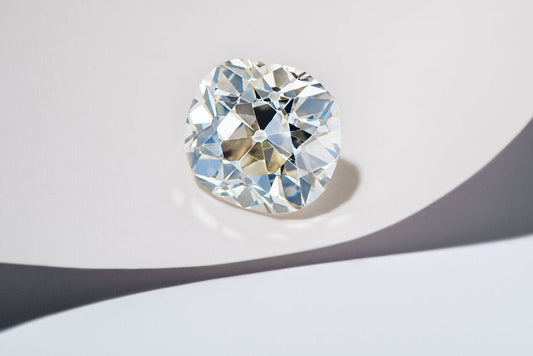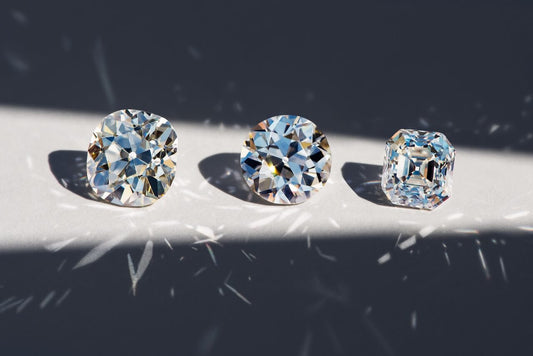Striking Sapphires come in a kaleidoscope of hues––and not just blues. There are the ultra-feminine (and extremely rare) orangish-pinks of Padparadscha Sapphires, the velvety blues of Kashmir Sapphires, the green and yellow tones that can be found in Australian Sapphires, and many more. Beyond their tranquil beauty, Sapphires are also one of the most durable coloured Gemstones––with a hardness second only to Diamonds. This makes them an excellent candidate for everyday wear.
At CUSHLA WHITING, our Gem Vault houses a meticulously curated collection of Australian Sapphires, Montana Sapphires, Nigerian Sapphires and Sri Lankan Sapphires. If we don’t happen to have the Sapphire you’re seeking, our Gemologist Hamish will work with you to find your ideal stone––no matter where it might be in the world.
THE SYMBOLISM
Wisdom, loyalty, inner peace.
THE BENEFITS
Durable: Second to Diamonds in hardness.
Distinctive: A celebration of colour.
Discerning: An ethical and affordable choice.
THE SCIENCE
Sapphire is a variety of the mineral corundum and is made up of aluminum and oxygen atoms. In its purest form (as an aluminum oxide) Sapphire is actually colourless however ‘pure’ colourless Sapphire is quite rare and crystals often contain trace amounts of other elements such as iron, titanium, chromium, vanadium, or magnesium.
A Sapphire’s colour is caused by the presence of these trace elements in the Sapphire crystal. When the crystal contains trace elements of titanium and iron it creates a blue body colour such as in blue Sapphire. When vanadium is present, we see a green body colour as displayed in green Sapphire, and the presence of chromium (in various quantities) gives rise to both the pink tones we see in pink Sapphire as well as the rich reds we see in Ruby. Combinations of these trace elements are also responsible for many of the other various hues that Sapphire is available in.
WHAT TO LOOK FOR
An expert eye will seek to increase the value of your Gemstone by assessing it through a critical lens. While there is currently no internationally agreed upon standard for grading coloured gems (as there is for Diamonds) there are many aspects that can affect a gem’s beauty and should be taken into consideration when selecting your stone.
Overall there are two key things we recommend to look for: COLOUR and CUT.
COLOUR
Colour is the most important factor when buying a Gemstone––it has the greatest impact on a Gemstone's value so it is an important factor to understand.
To more accurately describe a colour we can break it down into three key components:
- TONE is how dark or light the colour is.
- SATURATION refers to the intensity of colour or paleness.
- HUE refers to what colour is describing the primary and secondary colors of the stone, for example a greenish-blue Sapphire.
Historically, the most highly sought-after Sapphires were from the Ceylon or Kashmir regions and typically a medium tone with vivid saturation of a violet-blue colour. These types of Sapphire are still revered today for their intense even colour and beauty.
Today, the demand for “fancy” Sapphire colours has significantly increased. Stunning teals, oceanic blues and deeper forest greens are now featured in engagement rings around the world.
Hamish Whiting Gemologist tip: When buying a Gemstone of what is considered a trade colour like Padparadscha, we recommend certification to verify the stone’s provenance and authenticity as such colours can command a much higher price. At CW, we work with labs such as GRS GemResearch Swisslab AG and Gübelin Gem Lab. And, when selecting your own Sapphire, we recommend selecting a colour and tone that suits you rather than what might be popular at the time. A pleasing, even colour, or even a stone that has interesting bands of colour through it might be your preference - it really is up to you!
CUT
Cut is also an important factor when it comes to Sapphire not just for its overall shape but in relation to its colour. As Sapphire crystals grow in a hexagonal growth structure they can have ‘zones’ or patches of colour interspersed with colourless or less desirable colour zones. An experienced gem cutter knows how to orient the Gemstone they are cutting to achieve the most desirable colour - or combination of colours as is the case with “parti-colour” Sapphires.
As with Diamonds, the overall quality of the cut (which includes the symmetry and polish of the stone) plays an important role for any stone being set into a piece of jewellery. Our experienced team will guide you on the best cuts for your preferences.
CLARITY
Unlike Diamonds, there is no set grading system with specific clarity grades (like VS2 or SI1) for coloured stones. Instead, a Sapphire's clarity is based on its transparency—how clear the crystal is, and how numerous and visible any inclusions are. An eye-clean Sapphire with high levels of transparency is the highest-clarity quality and so commands a higher price. However, under magnification even in high-quality Sapphires it is common to find inclusions, colour zoning, natural silk, and other marks of the stone’s origins.
With the increasing number of synthetic or man-made Gemstones on the market, inclusions can actually be an excellent way to confirm if a Gemstone is natural and only a practiced eye (or trained Gemologist) can distinguish between them.
Some inclusions can also lend themselves to the beauty of the stone—for example the star effect seen in a star sapphire is actually caused by needle-like silk inclusions in the stone, that when oriented correctly by the cutter display a beautiful visual “star” effect across the stone.
At CUSHLA WHITING, we look at the quality and transparency of the stone and preference stones with few inclusions or inclusions that lend to its beauty. Most importantly, we avoid any inclusions that could pose a risk to the durability of the stone.
Now that you know what to look for, let’s take a look at some of our most-loved types of Sapphires.
—

AUSTRALIAN SAPPHIRES
THE HUES
Australian Sapphires can be found in a wide range of hues including deep midnight blues, medium-toned greenish blues, pure greens, yellows, and the rare and always unique “parti”.
ETHICAL SOURCING
Our Australian Sapphires are sourced directly from artisanal miners and cutters located in either the Central Queensland gemfields area (Rubyvale, Sapphire), or northern New South Wales near the town of Inverell. Australian Sapphires are cut by highly-skilled and experienced local gem cutters, whose standard of cutting is world class.
—

MONTANA SAPPHIRES
THE HUES
Montana is the only state in the USA that produces a significant quantity of gem quality Sapphire, earning it the nickname “the Treasure State”. Montana Sapphires are primarily known for their attractive oceanic teal blues and a very wide range of pastel colours.
ETHICAL SOURCING
Mining in Montana occurs in areas such as Rock Creek, El Dorado Bar and Spokane Bar along the upper Missouri River. It is carried out by several, generally small-scale, independent operations consisting of a small team of miners and some mechanised excavation equipment.
The vast majority of Montana’s rough material remains in the United States where it is finished by local cutters. American cutters are known for their high level of precision and craftsmanship, as well as their creativity. At CW, we source our Montana Sapphires directly from American cutters in Montana who we have formed relationships with over time.
—

NIGERIAN SAPPHIRES
THE HUES
Nigerian Sapphires come in a range of beautiful hues including, teal, green and royal blue––and are known for their naturally rich colour saturation and excellent clarity. Nigerian Sapphires offer one of the most beautiful sources of Sapphires and they are reasonably priced compared to more established Sapphire regions.
ETHICAL SOURCING
Our Nigerian Sapphires come from the agricultural areas around Gombe, Antang, and Mambilla in the central/northern highlands, where independent, artisanal Sapphire mining provides many local people with an additional source of income to traditional farming. In addition to this, the mining communities regularly receive both technical and non-technical assistance from the major dealers/exporters of Sapphires to help them identify and value their finds.
We buy our Sapphires directly from our trusted Nigerian local broker. He grew up in the area and regularly meets with the miners at either the digging sites, or in the local townships to purchase their rough.
—

SRI LANKAN SAPPHIRES
THE HUES
Sri Lanka (formerly known as Ceylon) is famed for its “Royal Blue” and “Cornflower Blue” Sapphires, which are very highly sought after for their intense even colour. While being known primarily for these hues, Sri Lanka is also a great source for “fancy” coloured Sapphires. We collect fine-quality Sri Lankan Sapphires in many colours including “royal” blue (vivid blue-violet with a deep tone), “cornflower” blue (pastel to medium colour tone, and a pure blue hue), light blue, pink, peach, violet and yellow.
ETHICAL SOURCING
The geological conditions of Sri Lanka means it has been blessed with some of the richest gem bearing gravels in the world. To this day, the area remains one of the single most important regions for Sapphire in the world. Because of this, mining practices in use today have centuries of tradition behind them.
At CW, we buy directly from Sri Lankan cutters based predominantly out of Beruwala and Colombo. Mining licenses in Sri Lanka are generally regulated by the National Gem and Jewellery Authority (NGJA) with most being issued for pit-style operations using traditional methods and commonly found in the mining areas of Ratnapura (which literally means city of gems), Elahera, and Balangoda. The miners dig down until they reach the gem-bearing gravels, which they haul up by hand for washing in hopes of finding Gemstone treasure. This philosophy allows mining and agriculture to coexist.
Cutting in Sri Lanka often relies on decades of experience rather than sophisticated or automated techniques. Sri Lankan cutters are globally renowned for their expertise in orienting rough crystals in a way that displays the maximum amount of colour saturation in a finished gem, and for being able to maintain impressively high yields from rough crystals once cut.
—
Now that you know what to look for in a Sapphire, we invite you to book an appointment with one of our CUSHLA WHITING Design and Gemstone Consultants to see our stunning collection of Sapphires with your own eyes.


